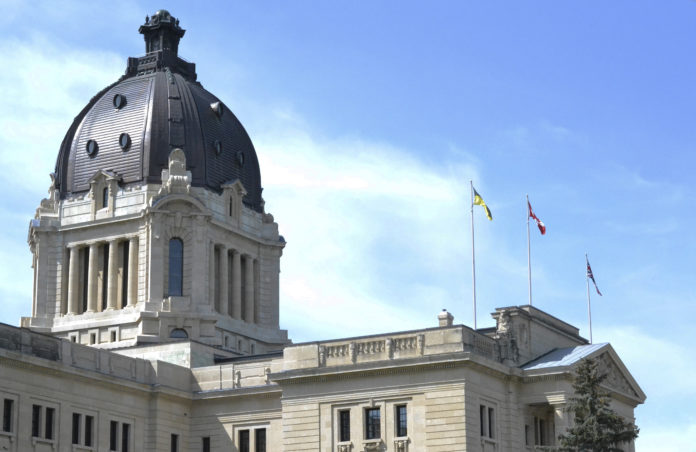An eight — and possibly ninth — Saskatchewan resident with COVID-19 has died, the province said Tuesday.
The eighth person to die after testing positive for COVID-19 was a resident in their 50s from Saskatchewan’s far north.
Speaking to reporters Tuesday, Premier Scott Moe said he is “saddened” to report another death. The ninth possible death was under investigation as of the media update Tuesday, though the province’s acting deputy medical health officer Dr. Denise Werker said local public health officials had entered it into their system sometime Tuesday and more information would be available today.
CBC reported Monday that a woman in her 60s from Île-à-la-Crosse had died after contracting COVID-19. Citing privacy concerns, the province wouldn’t confirm whether that woman is the same one whose death was under investigation.
“Our deepest condolences go to the family and friends of the deceased on what we know is a very difficult time,” Moe said.
There were no new COVID-19 cases reported Tuesday. Three more people had recovered from the virus. Moe said that marks 16 consecutive days of more recoveries than new cases.
The number of active cases now sits at 77, a sharp decline from the peak of 209 on May 10.
Just 12 of those cases are from outside the far north of the province. Five active cases are in the north, the region that includes Prince Albert, Melfort, North Battleford and Meadow Lake.
Much of Tuesday’s update was spent answering questions about emergency room closures in the southern part of the project, part of an effort by the Saskatchewan Health Authority (SHA) to train staff, ensure long-term and acute-care in mixed facilities could be cohorted and manage capacity.
There were concerns about how long the ER closures would last, and whether the closures would become permanent or spread to the whole facility.
Tuesday, Moe worked to quell those fears.
“With the number of active cases so low in the rest of the province, a number of people have voiced concern about the temporary closure of emergency rooms in 12 rural facilities,” Moe said.
“I share those concerns. I understand our health system has had to take some very difficult decisions to prepare for the potential and possible surge of COVID-19 patients in hospitals in communities across Saskatchewan. We have to be ready.”
The closure of emergency rooms in certain rural communities was originally announced as part of the health system readiness plan when original modelling numbers were announced.
Luckily, Moe said, the efforts of Saskatchewan residents to follow public health orders and physically distance has led to a much lower spread.
“Thanks to the actions of Saskatchewan people, our province has managed to avoid the kind of pressure in our hospital system we have seen in other places of this nation and the world,” he said.
That’s why portions of the economy and health care system, shuttered early on in the pandemic response, have been allowed to gradually reopen.
The closed emergency rooms will begin to reopen as well, beginning with Arcola in mid-June, with the others to follow shortly after.
“I know there have been rumours that the temporary disturbances are permanent. I can assure the people of Saskatchewan that this is not the case,” Moe said.
“It has always been the plan to open these facilities, and the sooner, the better.”
Health Minister Jim Reiter said that the communication of the closures and the reasons behind them could have been clearer.
“I’m a small-town kid. I’m very protective of the services we have, and a lot of people feel that same way,” he said.
“There was concern that the closure would become permanent — that’s not the case. That’s not the history of this government. That’s not the case for any of these facilities and … over the next couple of weeks you’ll see them reopen.”
The other change coming in June will be an easing of restrictions on visiting health care facilities. Currently, all visitors are banned, with the exception of compassionate care in certain circumstances.
Officials said Tuesday it’s a matter of balancing the need for visitors with the safety of the most vulnerable.
“We recognize how desperately patients in the hospital and seniors in long term care facilities would like visitors,” Reiter said.
We recognize that it is long-term care facilities especially where seniors are lonely and it’s very difficult for them.”
Reiter said SHA CEO Scott Livingstone and his staff were looking at ways to ease those restrictions. Livingstone said that’s being done in a way that won’t mean changing the public health order.
He said the SHA has established what they’re calling a “family presence expert panel” to guide on how to support having family present at SHA facilities. The panel is meeting weekly and taking action ‘quickly,” Livingstone said.
“This group of folks … we hope will develop much more consistent and timely guidelines on how patients are visited by family and loved ones,” he said.
“We’re going to be making some amendments to the definitions of a compassionate visit because we think we can expand that. The hope is we will be bringing this forward to ministers for decision and look at implementation on a phased-in strategy during the first week of June.”
Livingstone also said the province is also looking at expanding virtual visits, but knows that from the feedback that they’ve received that virtual visits simply aren’t enough.
Moe praised the efforts of residents and staff to keep hospital setting sand care homes mostly COVID-free. His comments came especially as other provinces, such as Ontario, are dealing with outbreaks in care homes and concerns about the state residents were living in.


